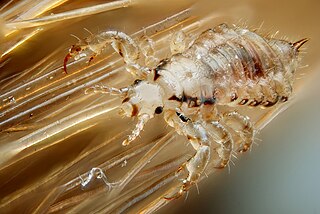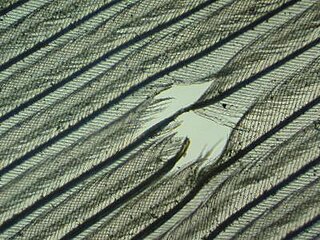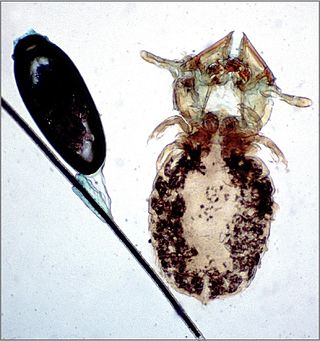Related Research Articles
Louse is the common name for any member of the clade Phthiraptera, which contains nearly 5,000 species of wingless parasitic insects. Phthiraptera has variously been recognized as an order, infraorder, or a parvorder, as a result of developments in phylogenetic research.

Sucking lice have around 500 species and represent the smaller of the two traditional superfamilies of lice. As opposed to the paraphyletic chewing lice, which are now divided among three suborders, the sucking lice are monophyletic.

The Ischnocera is a large superfamily of lice. They are mostly parasitic on birds, but including a large family parasitic on mammals. The genus Trichophilopterus is also found on mammals (lemurs), but probably belongs to the "avian Ischnocera" and represents a host switch from birds to mammals. It is a chewing louse, which feeds on the feathers and skin debris of birds. Many of the avian Ischnocera have evolved an elongated body shape. This allows them to conceal themselves between the feather shafts and avoid being dislodged during preening or flight.

The Amblycera are a large clade of chewing lice, parasitic on both birds and mammals. The Amblycera are considered the most primitive clade of lice.

The head louse is an obligate ectoparasite of humans. Head lice are wingless insects that spend their entire lives on the human scalp and feed exclusively on human blood. Humans are the only known hosts of this specific parasite, while chimpanzees and bonobos host a closely related species, Pediculus schaeffi. Other species of lice infest most orders of mammals and all orders of birds.

Menoponidae is a monophyletic family of lice in the superfamily of chewing lice, Amblycera, often referred to as the chicken body louse family. They are ectoparasites of a wide range of birds including chickens, which makes them important to understand for veterinary science and for human health. However, Menoponidae are not exclusive to poultry and are common parasites for migratory birds, with more and more species being discovered every year.

The body louse is a hematophagic ectoparasite louse that infests humans. It is one of three lice which infest humans, the other two being the head louse, and the crab louse or pubic louse.

Feather holes often characteristically occur on wing and tail feathers of some small-bodied species of passerines. In the case of barn swallows, it was suggested that the holes were feeding traces of avian lice, either Machaerilaemus malleus and/or Myrsidea rustica.

Paraneoptera or Acercaria is a superorder of insects which includes lice, thrips, and hemipterans, the true bugs. It also includes the extinct order Permopsocida, known from fossils dating from the Early Permian to the mid-Cretaceous.

Menacanthus is a genus of chewing lice which parasitise birds. The taxonomy of this genus is highly uncertain. Most taxonomies have given this genus as having over a hundred species, but recent studies have synonymised dozens of species and found other names to be invalid. Some Menacanthus species remain to be discovered, or are synonymised in error. Menacanthus lice feed on the blood of a wide variety of birds, including chickens, by piercing the quills of feathers and gnawing the epidermis. In doing so, they can spread disease and lower egg production. In Menacanthus stramineus, eggs are incubated for four or five days, each of the three nymphal stages lasts for about three days, and adult life for about twelve days. Females produce as many as four eggs in a day, averaging 1.6 eggs a day, with egg production peaking 5–6 days after reaching adulthood. On sparrows, Menacanthus lice are particularly common, and are found in many different niches, consuming blood and feathers.
Brueelia is a genus of bird lice in the family Philopteridae that infest Passerine (perching) birds. Lice in Brueelia are usually host specific, with more than 85% of described species each found on a single host bird species. Over 300 species of Brueelia have been described, and many more specimens that are presumed to belong to Brueelia are awaiting description and naming.

Trichodectes canis, also known as canine chewing louse, is a chewing louse found on domesticated dogs and wild canids throughout the world. T. canis is a well-known vector for the dog tapeworm, Dipylidium caninum. T. canis usually does not present any major problems to the host, however, can be very irritating in heavy infestations. In North America and most developed countries, T. canis infestation of domesticated dogs is very uncommon as long as they are properly cared for and healthy. Poorly taken care of dogs are more prone to getting a lice infestation.
Bovicola bovis is a cattle-biting louse found all over the world. It is a common pest of cattle of all types and sizes. They are one of many of the lice in the order Phthiraptera, but are divided from their blood sucking cousins in the sub-order Anoplura by the fact that they feed only by chewing. This makes B. bovis a member of the sub-order Mallophaga.

Polyplacidae is a family of lice in the suborder Anoplura, the sucking lice. Lice in this family are known commonly as the spiny rat lice. The family has a cosmopolitan distribution. As of 2010 there were 193 species.

The Ricinidae are a family of a larger group Amblycera of the chewing lice. All species are relatively large bodied avian ectoparasites. They typically exhibit low prevalence and low intensity. They feed on host blood which is atypical in chewing lice. Two or three genera are recognized.

Meromenopon is a genus of chewing lice which parasitise birds. The species Meromenopon meropsis is a parasite of bee-eaters.
Strigiphilus is a genus of chewing louse in the suborder Ischnocera. It was circumscribed in 1910 by Eric Mjöberg.

Colpocephalum is a genus of chewing louse. Christian Ludwig Nitzsch named the genus in 1818. The Plenary Powers of the International Commission on Zoological Nomenclature selected Colpocephalum zebraBurmeister, 1838 as its type species in the 1950s. There are approximately 135 species in this genus, and they are ectoparasites of birds in at least a dozen different orders.

Trichodectidae is a family of louse in the suborder Ischnocera. Its species are parasites of mammals. The following 19 genera are recognized:
Geomydoecus is a genus of louse in the suborder Ischnocera. They are parasites of gophers (Geomyidae). Species include:
References
- "Bird louse". Encyclopædia Britannica Online 2010. Retrieved 9 April 2010.]